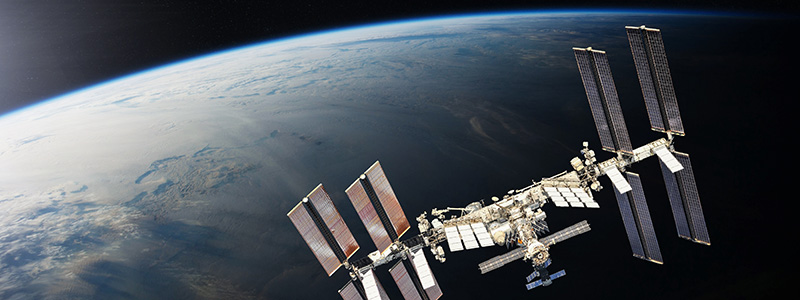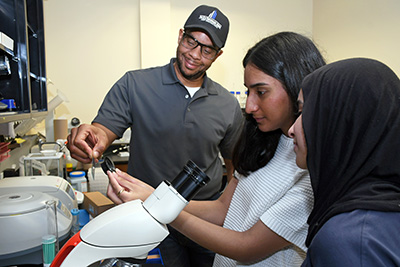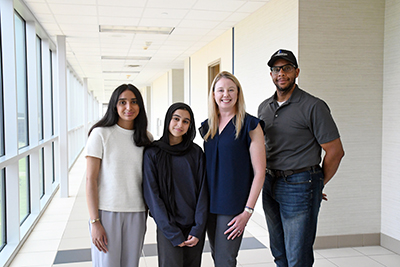Sky’s the limit: Students land research on International Space Station

Three … two … one … liftoff!
On Nov. 4, the ground shuddered as the SpaceX rocket roared off the launchpad at Kennedy Space Center. What made the sight even more spectacular to Marcus Pitre, Maheen Bukhari, and Amna Qureshi — sitting on bleachers at the nearest viewing site — was knowing their science experiment was aboard.
In fall 2023, a year earlier, 52 San Jacinto College students competed in the Student Spaceflight Experiments Program*, hoping to send their research projects on a supply mission to the International Space Station. Pitre, Bukhari, and Qureshi met through the South Campus STEM Club and formed a team with chemistry professor Dr. Carrie Owens as their advisor. They proposed using the mustard plant species "Arabidopsis thaliana" to measure cell wall growth in microgravity versus on Earth.

Their proposal won. But the hard part was still ahead: optimizing the experiment to fit inside a 7-inch mini lab operated by clamps an astronaut would open or close in space. Challenges ranged from sourcing NASA-approved supplies to finding lab space on campus to work together every week.
“This team is testing out something that’s never been done before,” Owens said. “Our department made sure we had all the supplies needed.”
All deadlines and safety checks met, their experiment finally launched in early November. Since their experiment returned to Earth approximately six weeks later, they have been comparing the results of the microgravity and ground control experiments.
What’s next for the teammates? Bukhari and Qureshi are both completing associate degrees at the College through Clear Horizons Early College High School, with Bukhari eyeing a science career and Qureshi biomedical engineering or cybersecurity. Pitre, a computer engineer, is taking prerequisites to reskill for a critical care medicine career.

Although Pitre has managed teams before, he gained an appreciation for the planning, checks, and balances behind every launch.
“One thing I always leave with [my teams] is we don’t manage time — we manage our use of time,” he said. “That’s what we need to succeed with these ventures. This team did a good job of that.”
Bukhari remembers her parents’ surprise as she broke the news about their team winning the space competition.
“It was very unexpected,” Bukhari said. “I didn’t think we’d be the team.”
Lesson learned: Prepare for the unexpected.
*The Student Spaceflight Experiments Program [or just “SSEP”] is a program of the National Center for Earth and Space Science Education (NCESSE) in the U.S. and the Arthur C. Clarke Institute for Space Education Internationally. It is enabled through a strategic partnership with Nanoracks LLC, which is working with NASA under a Space Act Agreement as part of the utilization of the International Space Station as a National Laboratory.
Read more stories from the Chancellor's Report to the Community
About San Jacinto College
Surrounded by monuments of history, evolving industries, maritime enterprises of today, and the space age of tomorrow, San Jacinto College has served the people of East Harris County, Texas, since 1961. The College is ranked second in the nation among more than 1,100 community colleges, as designated by the Aspen Institute and was named an Achieving the Dream Leader College of Distinction in 2020. As a Hispanic-Serving Institution that spans five campuses, plus an online college, San Jacinto College serves approximately 45,000 credit and non-credit students annually. It offers more than 200 degrees and certificates across eight major areas of study that put students on a path to transfer to four-year institutions or enter the workforce. The College is fiscally sound, holding bond ratings of AA+ by Standard & Poor’s and Aa2 by Moody’s.
